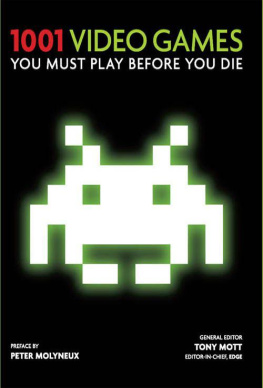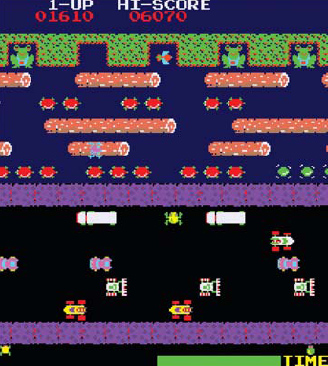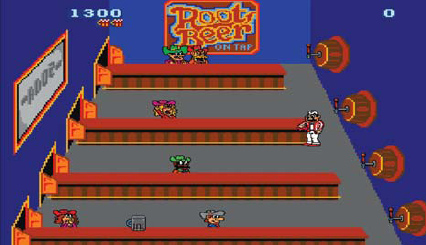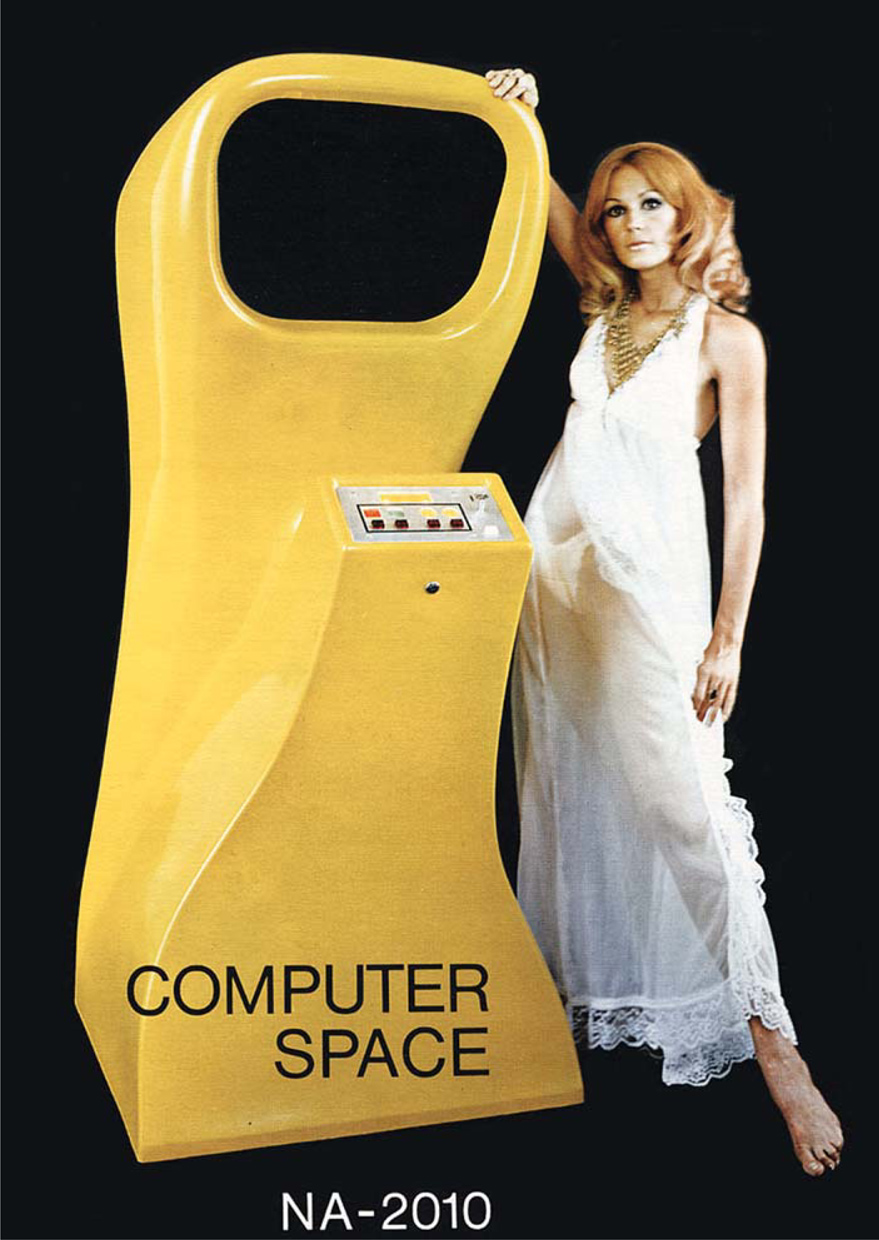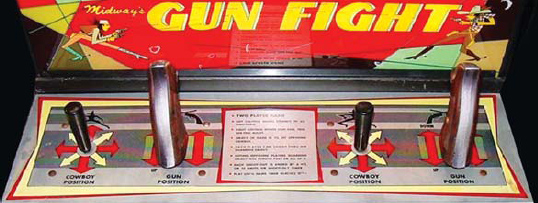CLASSIC VIDEO GAMES
THE GOLDEN AGE 19711984
Brian R. Eddy
SHIRE PUBLICATIONS
In Frogger, when in attract mode when the frog reaches the last log before his home, the player can control the final jump without putting any money in the game.
CONTENTS
During development, Tapper had a digitized burp sound effect designed to match the action of bar patrons, but it was so obnoxious that developers removed it before production.
Computer Space is widely recognized as the first commercial coinoperated arcade game.
IN THE BEGINNING: AN INDUSTRY IS LAUNCHED (197177)
A RCADE GAMES HAVE BEEN AMUSINGYOUNG AND OLD alike for more than a century. Though electronic games were invented as early as the late 1940s, it wasnt until decades later that the Golden Age of video games would be born, as arcade games like coin-operated pinball gave way to electromechanical games and later to fully electronic video games. The birth of the first commercial standup video arcade game occurred in 1971 with the release of Computer Space. Most games of this era were very simple with black-and-white graphics and color screen overlays. They introduced players to the idea of playing a game on a video screen. Some initial successes in this time period, like Pong, alerted the public to this new form of entertainment, but it had yet to reach mass appeal. Games started showing up in bars, pool and pinball halls, bowling alleys, and other places of entertainment. Although the games were simple, it was the start of a trend.
COMPUTER SPACE
Computer Space was created by Nolan Bushnell and Ted Dabney, who later formed Atari. Widely considered the first commercial video game, it was produced by Nutting Associates, and it set the format for future video arcade machines by putting a stand-alone game with a video screen in an upright cabinet that accepted money for play. Computer Space featured a cabinet unique even by todays standards, as it was made of fiberglass and had a flowing, wraparound design in a variety of colors, most in a sparkly metal flake paint.
The coin box in Computer Space was a paint-thinner can.
Computer Space was based on a computer game called Space Wars that was developed in 1961 at Massachusetts Institute of Technology using one of the first minicomputers, the PDP-1. (Space Wars was never available to the public.) In Computer Space, the player controlled a rocket ship with a thrust button and two directional rotation buttons. Against a backdrop of stars, enemy flying saucers would move across the screen and try to shoot and destroy the player. In turn, the player pressed a button that would shoot missiles in an attempt to destroy the enemy saucers. The game was played in rounds that lasted ninety seconds. If the player had the most kills, he could continue for another ninety seconds; if not, it was game over. This sequence continued until the player lost to the enemy saucers.
In 1975, Magnavox sued Atari for patent infringement on the similar Odyssey home pong game. They won, so Atari and others had to pay a licensing fee to Magnavox.
Initially released as a one-player game, Computer Space later was released in a twoplayer version, and the directional rotation buttons were changed to joysticks. This version allowed players to compete head to head. While the game was popular on college campuses, it was not a success for the general public and sold only 1,500 units. The game play was considered too complex to grasp for an average player who was just having a pint at a pub.
PONG
In 1972, Bushnell and Dabney formed Atari, Inc., with money raised by the profits from Computer Space. Pong was the companys first game, and it is considered the first commercially successful arcade game, eventually selling 35,000 units. The game was created by Atari employee Al Alcorn and was inspired by a similar game on the Magnavox Odyssey home video game system, which Bushnell had seen in a demonstration while visiting Magnavox.
Pong is a video version of tennis for one or two players. Each player has a paddle on the opposite side of the screen used to hit a ball back and forth. If one player misses, the other scores a point. The player with the most points wins. The simplicity and head-to-head competition of this classic game made Pong an instant hit. For many, it was the first video game they ever played. Pongs success led to it being widely cloned by others in the arcade and home market, and it remains one of the most famous arcade games ever made.
Western Gun, the predecessor to Gunfight, was designed by Tomohiro Nishikado, who later went on to design Space Invaders.
GUNFIGHT
In 1975, Midway Manufacturing, a pinball and mechanical coinoperated device maker established in 1932, released the popular game Gunfight, which was based on the Japanese Taito game Western Gun. The game was black and white but included a yellow screen overlay to simulate color. A western-themed shootout, Gunfight featured a unique controller layout with two joysticks. Players moved the character on screen and provided a trigger to shoot a gun at their opponent; the other controlled the aim of the gun. Players could square off against the computer or a human opponent. The one with the most hits won.
Gunfights controller was shaped like the grip of a gun.
Gunfight is notable for a number of firsts in an arcade game: It was the first to be controlled by a central microprocessor instead of separate circuits, and it was the first successful Japanese arcade video game to be exported to North America. It also was the first arcade video game to feature a gun on screen, a trend that would continue into the foreseeable future.
NIGHT DRIVER
In late 1976, Atari introduced Night Driver, the first arcade driving game to feature first-person perspective graphics. This made players feel like they were in the car looking through the windshield when driving. The simple game consisted of black-and-white markers to define the road as it moved toward the player. In Night Driver, the player used a steering wheel to control the vehicle, a gas pedal to move forward, and a four-position gear shifter to go as fast as possible down a winding road at night. The longer the player drove without crashing, the faster the car would go, the more points scored, and the harder it became to maintain control through the turns. This increasing speed led to an adrenalin rush for players trying to survive as long as they could before crashing. When time ran out, the game was over. Night Driver came in two popular formats: an upright cabinet and a flagship sit-down fiberglass cockpit.

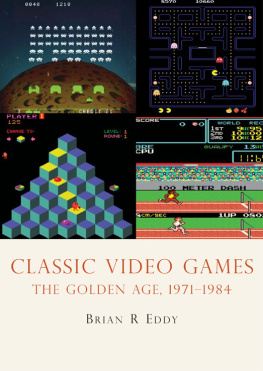
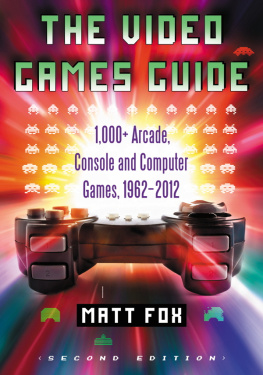





![Mark J. P. Wolf (editor) - Encyclopedia of Video Games: The Culture, Technology, and Art of Gaming [3 volumes]](/uploads/posts/book/279290/thumbs/mark-j-p-wolf-editor-encyclopedia-of-video.jpg)

